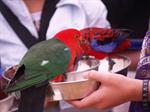 Learn how to examine sick animals, and how to collect symptomatic information or tissue samples that will aid in making a diagnosis.
Learn how to examine sick animals, and how to collect symptomatic information or tissue samples that will aid in making a diagnosis.
The course will help you to recognise a disease and determine an appropriate course of action to initiate in order to obtain a diagnosis.